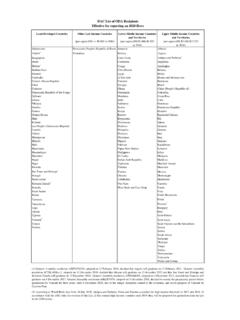Transcription of Labor Market Equilibrium - Harvard University
1 Confirming Pages Chapter 4. Labor Market Equilibrium Order is not pressure which is imposed on society from without, but an Equilibrium which is set up from within. Jos Ortega y Gasset Workers prefer to work when the wage is high, and firms prefer to hire when the wage is low. Labor Market Equilibrium balances out the conflicting desires of workers and firms and determines the wage and employment observed in the Labor Market . By understanding how Equilibrium is reached, we can address what is perhaps the most interesting question in Labor economics: Why do wages and employment go up and down? This chapter analyzes the properties of Equilibrium in a perfectly competitive Labor Market . We will see that if markets are competitive and if firms and workers are free to enter and leave these markets, the Equilibrium allocation of workers to firms is efficient;. the sorting of workers to firms maximizes the total gains that workers and firms accumu- late by trading with each other.
2 This result is an example of Adam Smith's justly famous invisible hand theorem, wherein Labor Market participants in search of their own self- ish goals attain an outcome that no one in the Market consciously sought to achieve. The implication that competitive Labor markets are efficient plays an important role in the fram- ing of public policy. In fact, the impact of many government programs is often debated in terms of whether the particular policy leads to a more efficient allocation of resources or whether the efficiency costs are substantial. We also will analyze the properties of Labor Market Equilibrium under alternative Market structures, such as monopsonies (where there is only one buyer of Labor ) and monopolies (where there is only one seller of the output). Each of these Market structures generates an Equilibrium with its own unique features. Monopsonists, for instance, generally hire fewer workers and pay less than competitive firms.
3 Finally, the chapter uses a number of policy applications such as taxes, subsidies, and immigration to illustrate how government policies shift the Labor Market to a differ- ent Equilibrium , thereby altering the economic opportunities available to both firms and workers. 144. 144 27/10/11 10:58 AM. Confirming Pages Labor Market Equilibrium 145. 4-1 Equilibrium in a Single Competitive Labor Market We have already briefly discussed how a competitive Labor Market attains Equilibrium . We now provide a more detailed discussion of the properties of this Equilibrium . Figure 4-1 illus- trates the familiar graph showing the intersection of Labor supply (S) and Labor demand (D). curves in a competitive Market . The supply curve gives the total number of employee- hours that agents in the economy allocate to the Market at any given wage level; the demand curve gives the total number of employee-hours that firms in the Market demand at that wage.
4 Equilibrium occurs when supply equals demand, generating the competitive wage w* and employment E*. The wage w* is the Market -clearing wage because any other wage level would create either upward or downward pressures on the wage; there would be too many jobs chasing the few available workers or too many workers competing for the few available jobs. Once the competitive wage level is determined in this fashion, each firm in this industry hires workers up to the point where the value of marginal product of Labor equals the com- petitive wage. The first firm hires E1 workers; the second firm hires E2 workers; and so on. The total number of workers hired by all the firms in the industry must equal the Market 's Equilibrium employment level, E*. FIGURE 4-1 Equilibrium in a Competitive Labor Market The Labor Market is in Equilibrium when supply equals demand; E* workers are employed at a wage of w*.
5 In Equilibrium , all persons who are looking for work at the going wage can find a job. The triangle P gives the producer surplus; the triangle Q gives the worker surplus. A competitive Market maximizes the gains from trade, or the sum P Q. Dollars S. P. w*. Q. D. EL E* EH Employment 145 27/10/11 10:58 AM. Confirming Pages Theory at Work THE INTIFADAH AND PALESTINIAN WAGES. Throughout much of the 1980s, nearly 110,000 Pales- of work days in a month dropped from 22 to 17; and the tinians who resided in the occupied West Bank and gaza length of time it took a commuting Palestinian to reach the Strip commuted to Israel for their jobs. Many of these work location rose from 30 minutes to three or four hours. Palestinians were employed in the construction or agri- The Intifadah, therefore, greatly reduced the sup- culture industries. ply of Palestinian commuters in Israel. The supply and As a result of the Intifadah the Palestinian uprising demand framework suggests that the uprising should against Israeli control of the West Bank and gaza territo- have increased the Equilibrium wages of these Palestin- ries that began in 1988 there were major disruptions ian workers.
6 In fact, this is what occurred. The roughly in the flow of these workers into Israel. Israeli authorities, 50 percent cut in the Labor supply of Palestinian com- for instance, stepped up spot checks of work permits and muters increased their real wage by about 50 percent, began to enforce the ban on Palestinians spending the implying that the demand elasticity for Palestinian com- night in Israel, while strikes and curfews in the occupied ter- muters is on the order of 1. ritories limited the mobility of commuting workers. Within one year, the daily absenteeism rate jumped from less than Source: Joshua D. Angrist, Short-Run Demand for Palestinian Labor , Journal of Labor Economics 14 (July 1996): 425 453. 2 percent to more than 30 percent; the average number As Figure 4-1 shows, there is no unemployment in a competitive Labor Market . At the Market wage w*, the number of persons who want to work equals the number of workers firms want to hire.
7 Persons who are not working are also not looking for work at the going wage. Of course, many of these persons would enter the Labor Market if the wage rose (and many would withdraw if the wage fell). Needless to say, a modern industrialized economy is continually subjected to many shocks that shift both the supply and demand curves. It is unlikely, therefore, that the Labor Market actually ever reaches a stable Equilibrium with wages and employment remaining at a con- stant level for a long time. Nevertheless, the concept of Labor Market Equilibrium remains useful because it helps us understand why wages and employment seem to go up or down in response to particular economic or political events. As the Labor Market reacts to a par- ticular shock, wages and employment will tend to move toward their new Equilibrium level. Efficiency Figure 4-1 also shows the benefits that accrue to the national economy as workers and firms trade with each other in the Labor Market .
8 In a competitive Market , E* workers are employed at a wage of w*. The total revenue accruing to the firm can be easily calculated by adding up the value of marginal product of the first worker, the second worker, and all workers up to E*. This sum, in effect, gives the value of the total product produced by all workers in a competitive Equilibrium . Because the Labor demand curve gives the value of marginal product, it must be the case that the area under the Labor demand curve gives the value of total product. Each worker receives a wage of w*. Hence, the profits accruing to firms, which we call producer surplus, are given by the area of the triangle 1. To simplify the discussion, assume that Labor is the only factor in the production function. 146. 146 27/10/11 10:58 AM. Confirming Pages Labor Market Equilibrium 147. Workers also gain. The supply curve gives the wage required to bribe additional work- ers into the Labor Market .
9 In effect, the height of the supply curve at a given point mea- sures the value of the marginal worker's time in alternative uses. The difference between what the worker receives (that is, the competitive wage w*) and the value of the worker's time outside the Labor Market gives the gains accruing to workers. This quantity is called worker surplus and is given by the area of the triangle Q in Figure 4-1. The total gains from trade accruing to the national economy are given by the sum of producer surplus and worker surplus, or the area P Q. The competitive Market maximizes the total gains from trade accruing to the economy. To see why, consider what the gains would be if firms hired more than E* workers, say EH. The excess workers have a value of marginal product that is less than their value of time elsewhere. In effect, these workers are not being efficiently used by the Labor Market ; they are better off elsewhere.
10 Simi- larly, consider what would happen if firms hired too few workers, say EL. The missing . workers have a value of marginal product that exceeds their value of time elsewhere, and their resources would be more efficiently used if they worked. The allocation of persons to firms that maximizes the total gains from trade in the Labor Market is called an efficient allocation. A competitive Equilibrium generates an efficient allocation of Labor resources. 4-2 Competitive Equilibrium across Labor Markets The discussion in the previous section focused on the consequences of Equilibrium in a single competitive Labor Market . The economy, however, typically consists of many Labor markets, even for workers who have similar skills. These Labor markets might be differen- tiated by region (so that we can talk about the Labor Market in the Northeast and the Labor Market in California), or by industry (the Labor Market for production workers in the auto- mobile industry and the Labor Market for production workers in the steel industry).
















